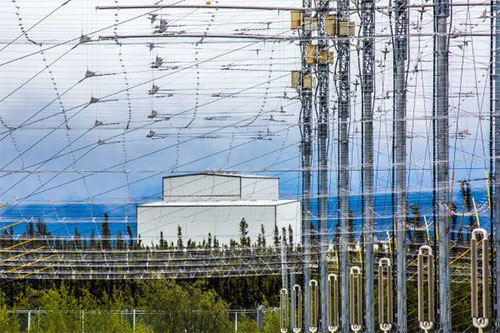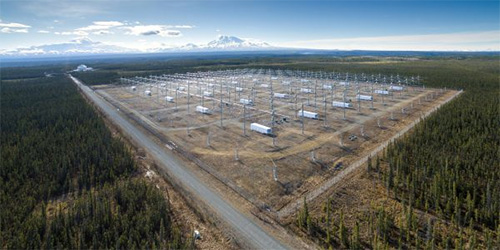
ALASKA SCIENCE HAARP ready for business under UAF managementBy NED ROZELL
September 22, 2016
The field of radio transmitters designed to heat portions of space has not operated since 2014. The University of Alaska Fairbanks Geophysical Institute took it over from the U.S. Air Force in 2015. Despite that inactivity, 350 people were curious enough to travel to Gakona on Aug. 27 and explore the HAARP facility during an open house held by faculty and staff members of the Geophysical Institute. Long a conversation piece for people who questioned what Department of Defense scientists were doing in the Copper River Valley far from any town, HAARP will soon host its first campaigns under university ownership.
The High Frequency Active Auroral Research Program facility near Gakona is used to conduct research on the ionosphere. HAARP was built and operated by the U.S. Air Force until 2015, when ownership was transferred to the University of Alaska Fairbanks.
“We aim to get 60 percent of the array functional by February,” Bristow said. That amount of capability will be enough to conduct the initial experiments. Geophysical Institute scientists will fire the transmitters as part of a three-year experiment involving a few elements of complicated space physics. The Los Alamos researchers will use HAARP to generate irregularities in the ionosphere to test satellite-to-ground communications under conditions similar to solar storms. Large solar storms can disrupt communications and sometimes take out power grids. HAARP is a group of high-frequency radio transmitters powered by four diesel tugboat generators and one from a locomotive. The transmitters send a focused beam of radio-wave energy into the aurora zone. There, that energy can stimulate a speck of the electrical connection between the sun and Earth about 100 miles above our heads. Since it opened 13 years ago with funding the late Ted Stevens helped secure, HAARP has hosted many scientists doing applied research for the military. One such study used the antenna array to heat a part of the ionosphere, which in turn acted as a low-frequency antenna that could send an ocean-penetrating signal to a submarine. That transmission could tell a submarine captain to surface in order to receive conventional radio communications.
HAARP includes a 40-acre grid of antenna towers, comprising the most powerful ionospheric heater in the world.
The military experiments and the complex nature of studying a region people can’t see or easily understand have fed the controversy about HAARP. Shortly after it opened, Nick Begich wrote a book, “Angels Don’t Play This HAARP.” The British band Muse recorded a live album called HAARP from Wembley Stadium from a stage that featured antennas meant to resemble those in Gakona. Despite the facility being a magnet for conspiracy theorists, Geophysical Institute Director Bob McCoy thought HAARP was too valuable to fall to the dozer blade. With a $2 million loan from the university, McCoy has wagered that space physics researchers will use HAARP. The Geophysical Institute plans to run it in a similar manner to Poker Flat Research Range in Chatanika. The HAARP facility, built for $290 million, is the best tool to study a region above Earth we know little about, McCoy said. HAARP is the most powerful and capable of four such ionospheric heaters in the world, which include facilities in Norway, Russia and in Puerto Rico. McCoy and Bristow hope the February experiments will help attract customers to HAARP by showcasing UAF’s ability to run it. At the 2015 transfer of HAARP to the university, McCoy mentioned a timeline of finding customers within three years. As technicians at the site replace vacuum tubes and lubricate moving capacitor plates that make up the powerful radio-frequency transmitters, HAARP is readying for its first customers of a new era. “We’d of course like to have more than what we have now, but it’s a start,” Bristow said.
Related News:
Representations of fact and opinions in comments posted are solely those of the individual posters and do not represent the opinions of Sitnews.
|
||

